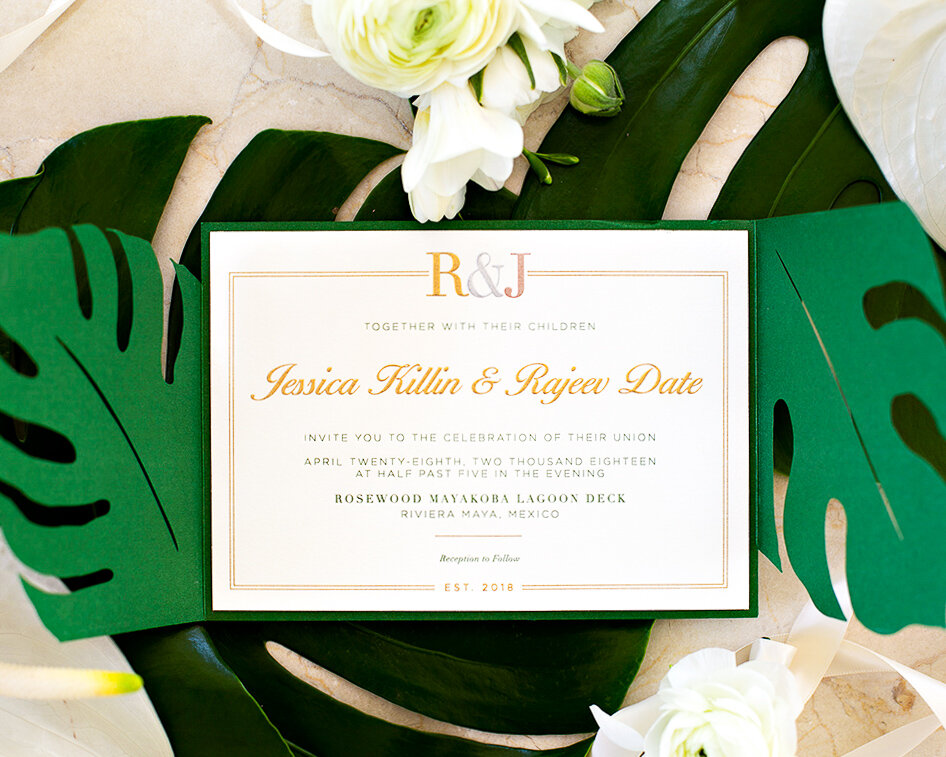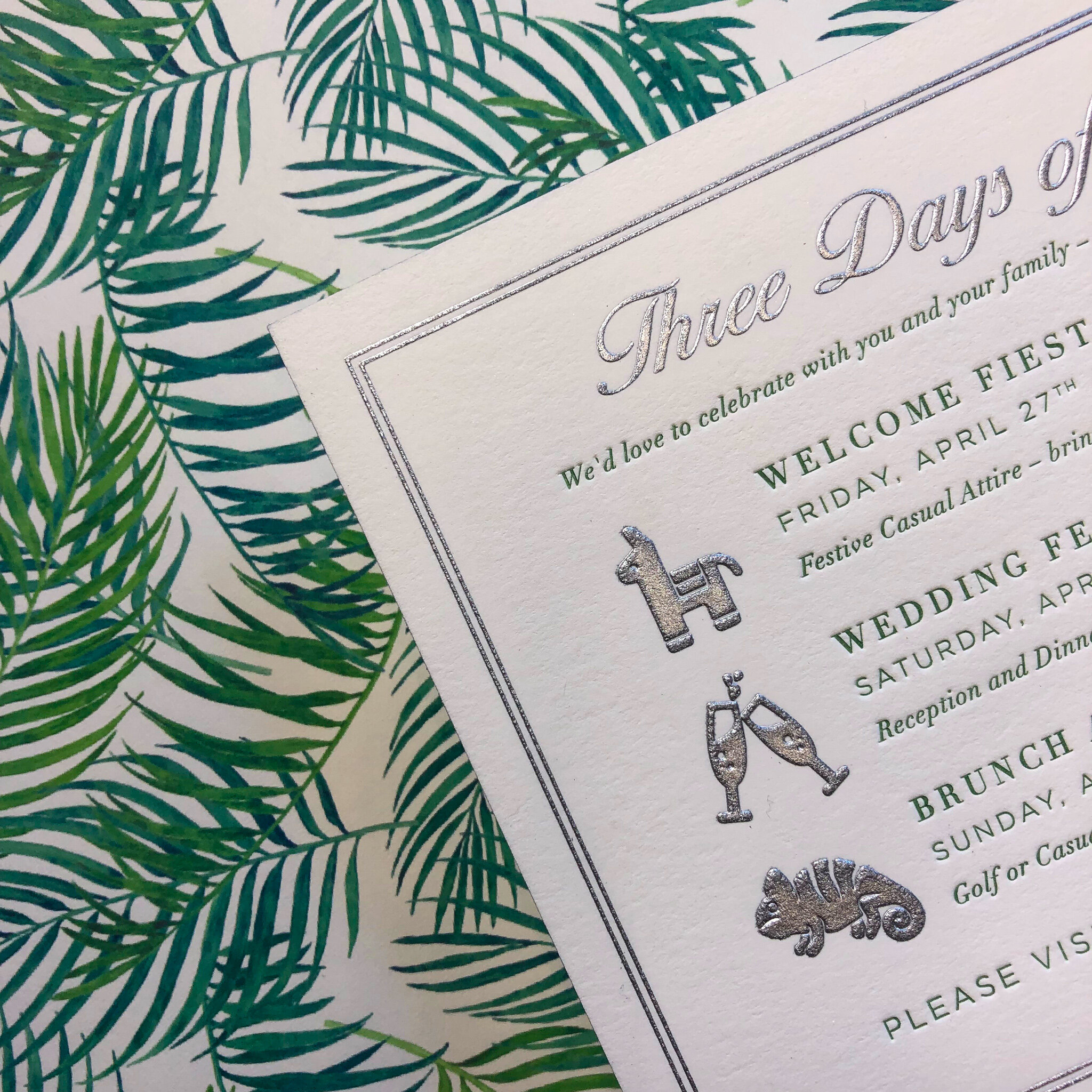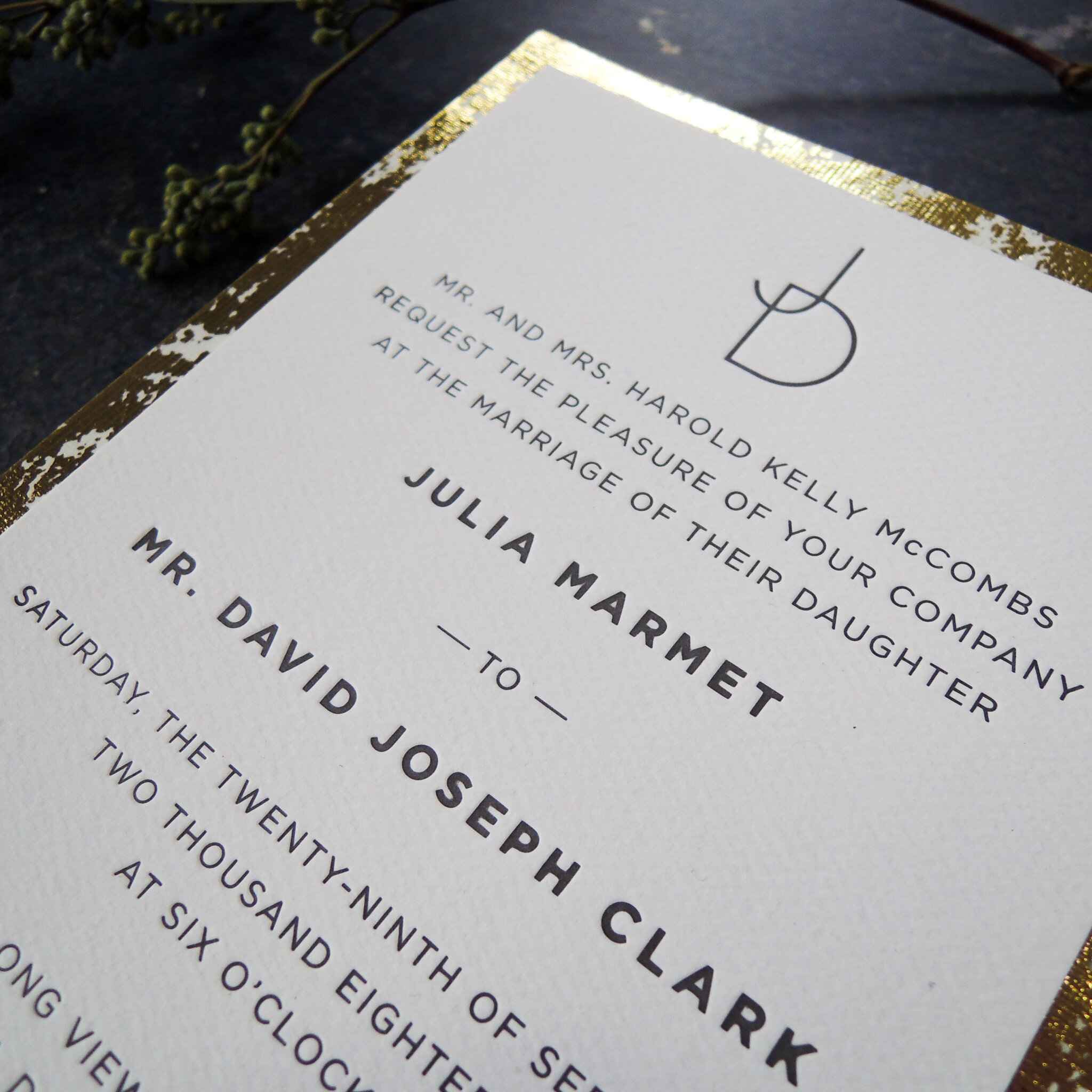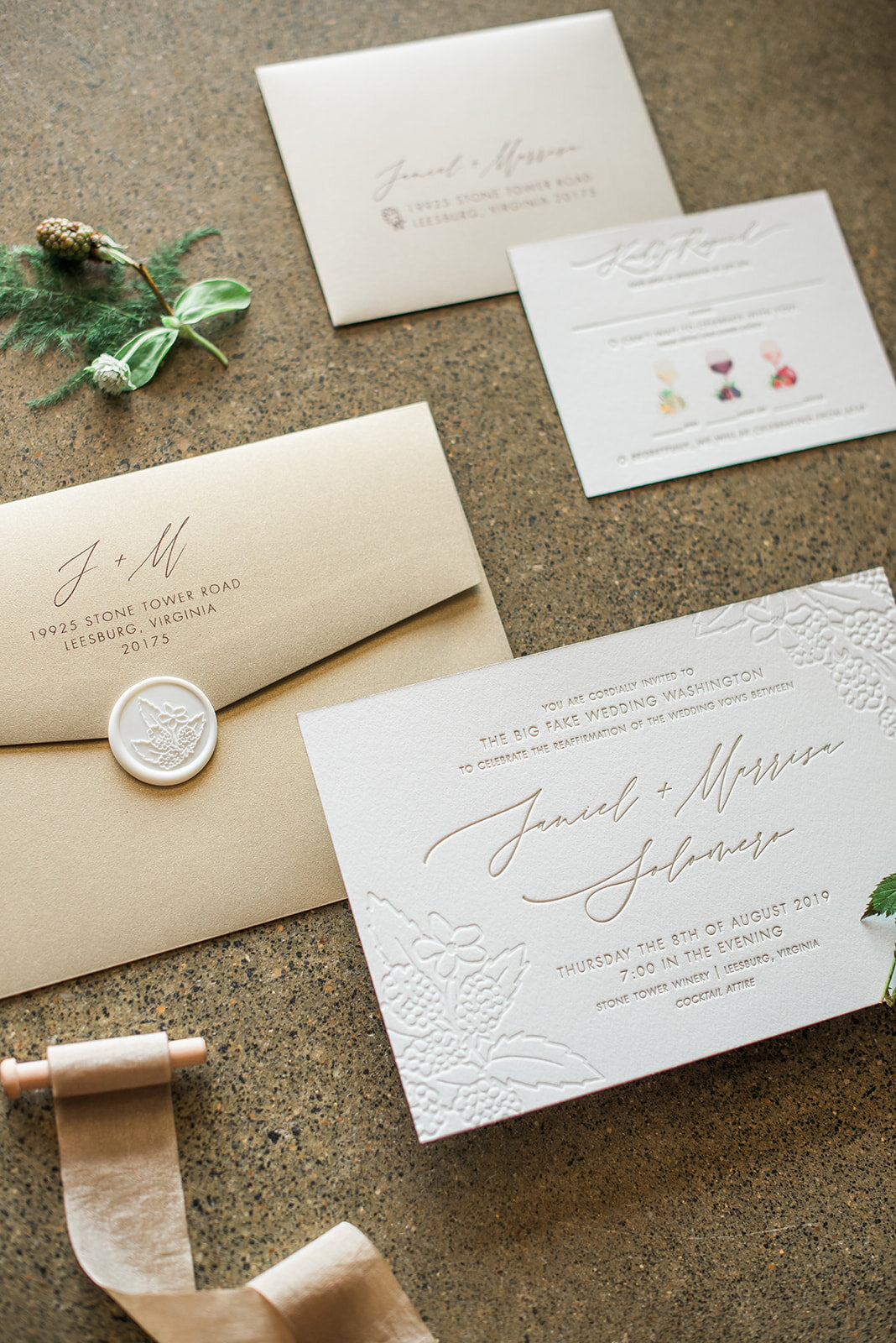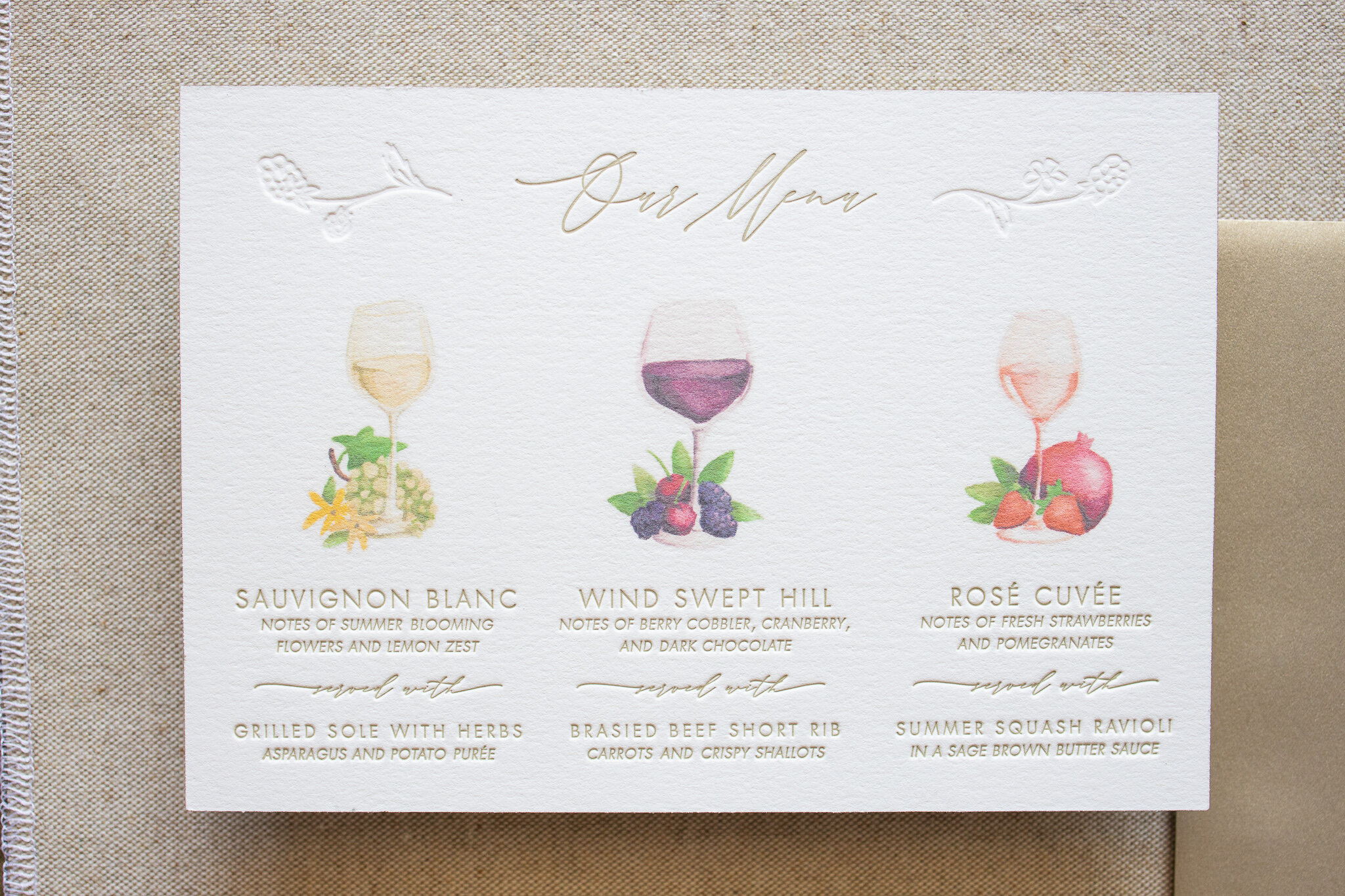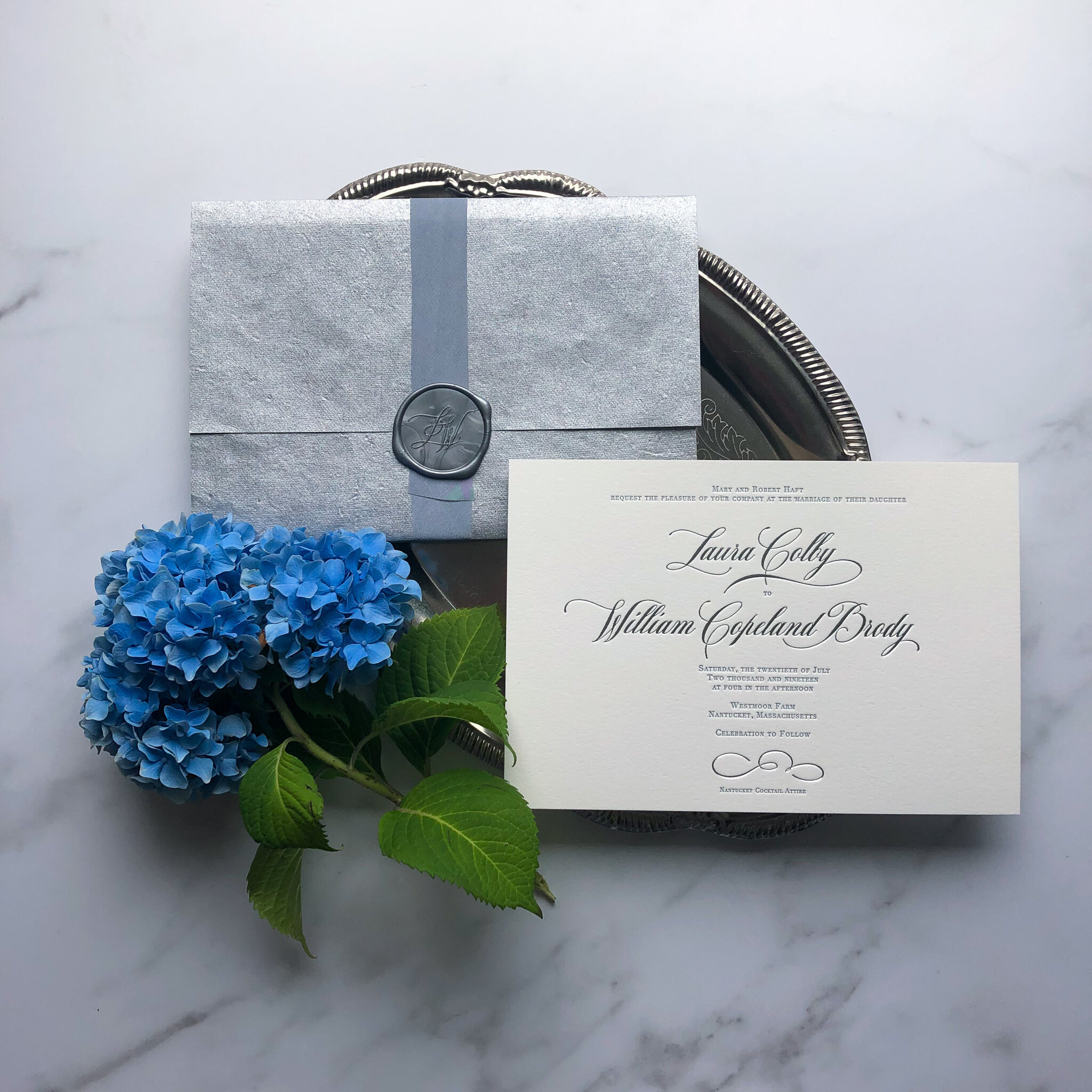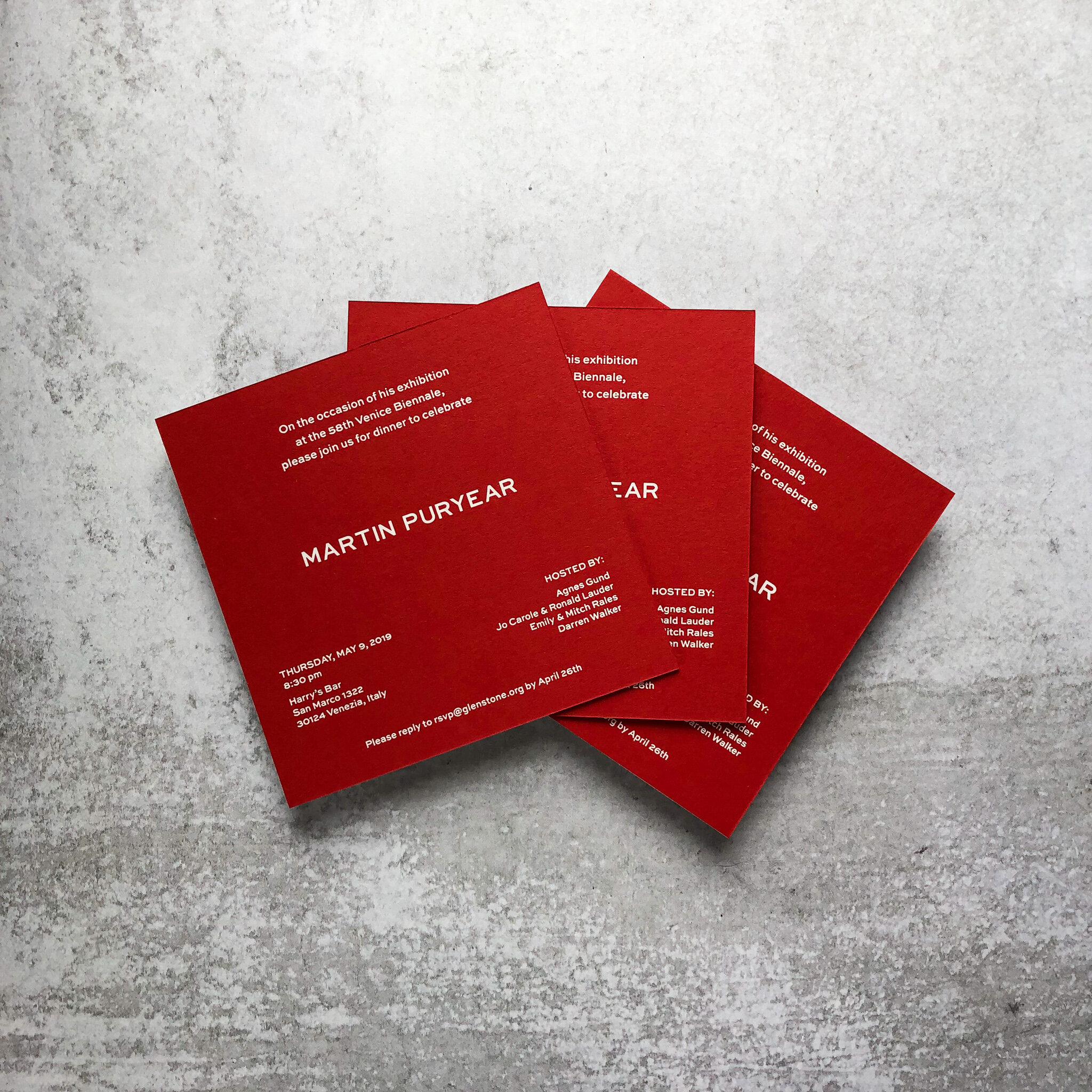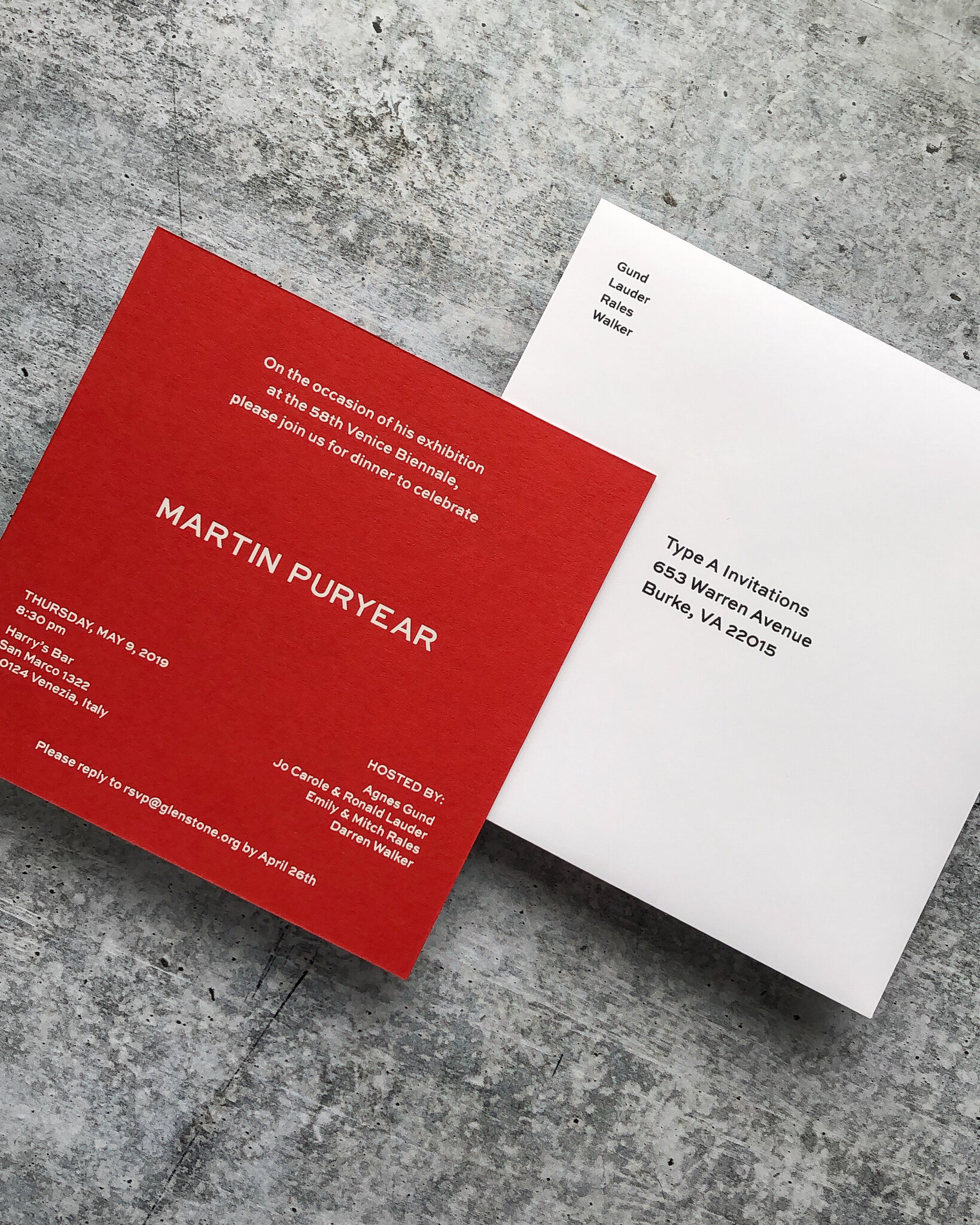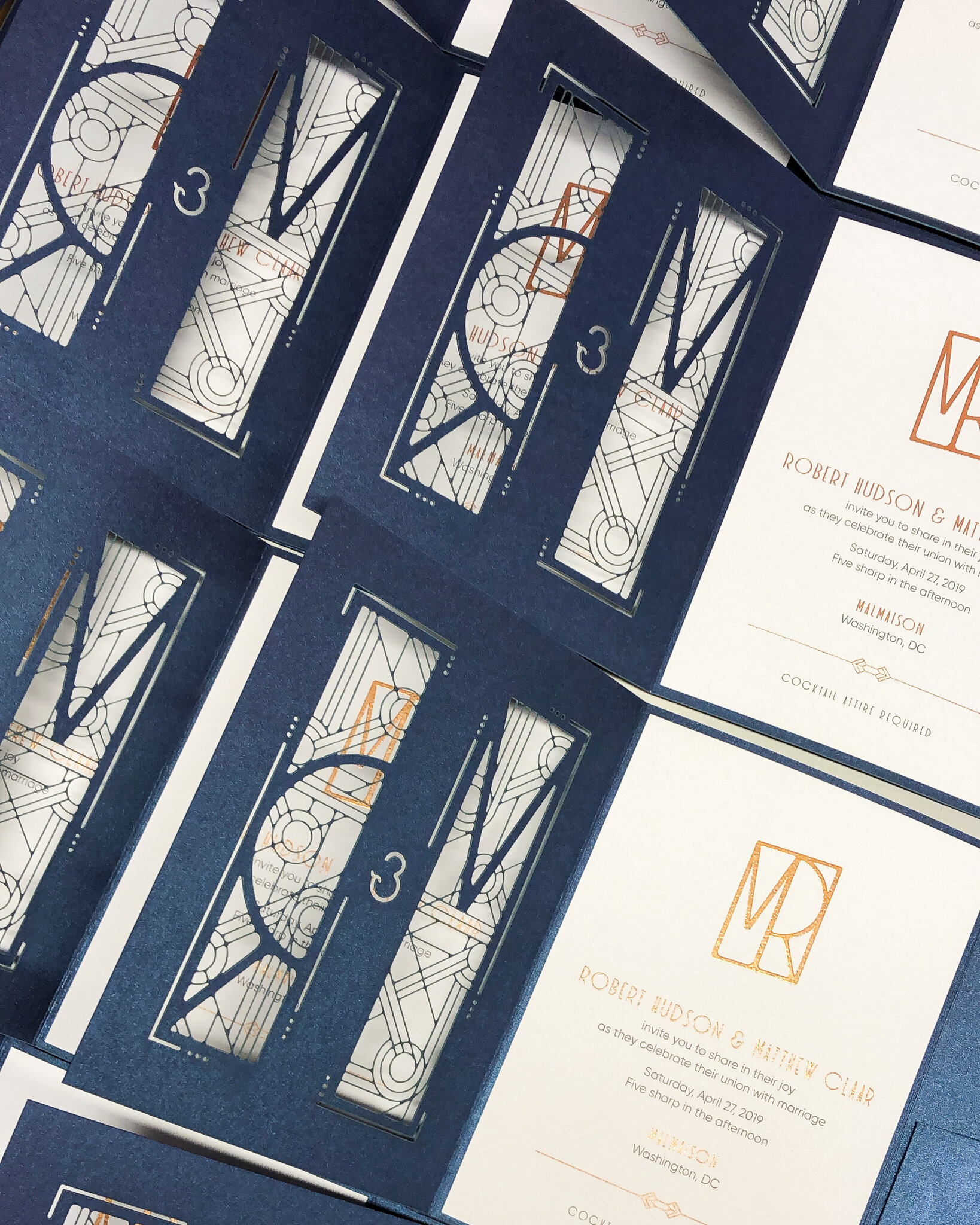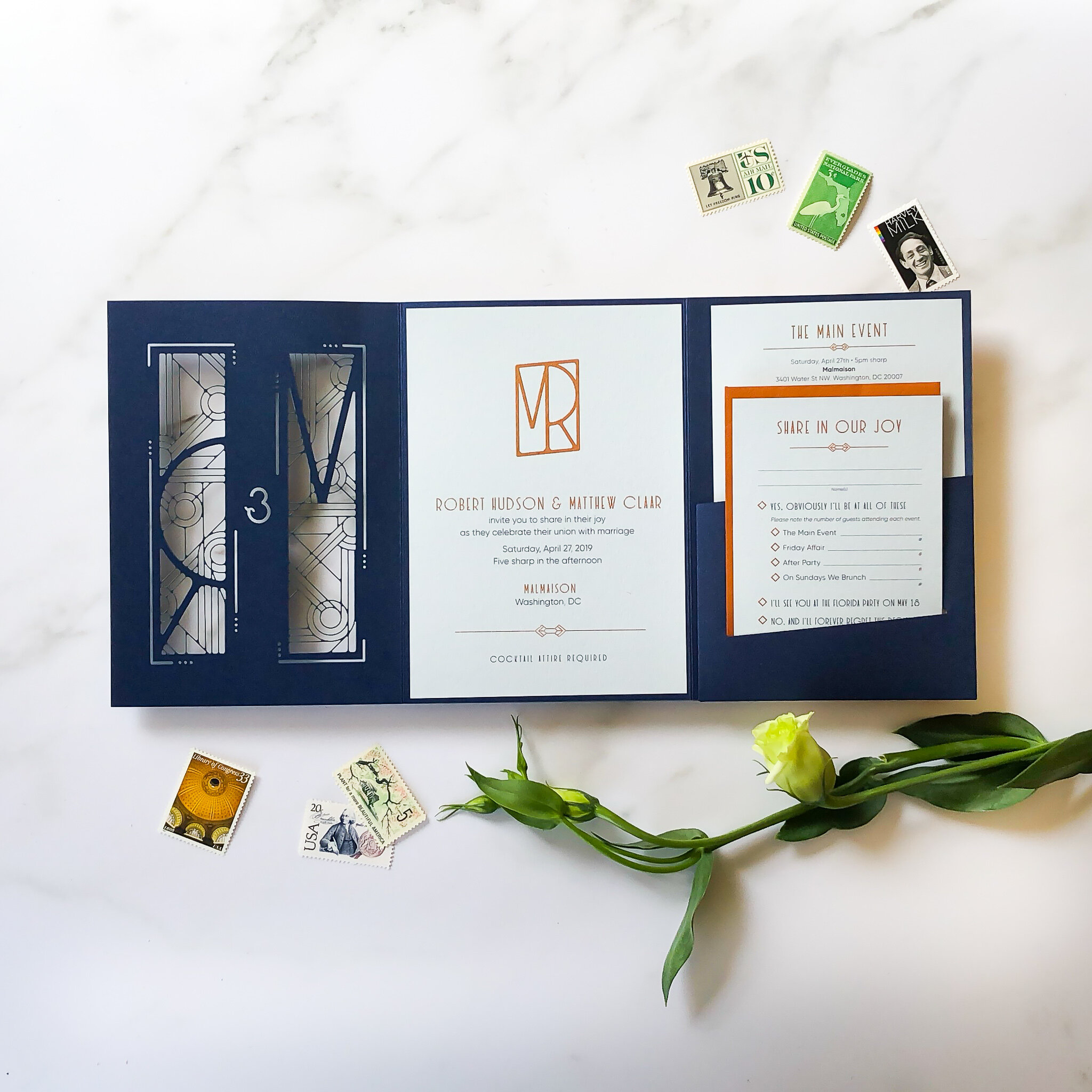Type A's Guide to Printing Methods & Processes
Unless you’re a designer, professional printer, or artist — or know a designer, professional printer, or artist (because we’re usually nerdy enough to bring up printing methods at the dinner table 🤓) — you probably don’t know a lot about printing processes. Deciding on your invitation style can be hard enough before words like “letterpress” and “thermography” get thrown around. That’s why we’ve created this guide, to make the process much smoother and get you in-the-know!
Engraving
Engraving is the ultimate luxury printing method. It dates back to 1446 and has lasted due to it’s ability to beautifully print precise details. This is achieved by etching a design onto a copper plate, called a die. Ink is applied to to the plate then wiped off, leaving ink only in the cavities. Another plate, the counter, is placed behind the paper. When pressure is applied, it forces the paper up into the crevices of the die resulting in a stunning engraved piece.
Engraving can be done in multitudes of colors, matte and metallic. The overall effect is similar to Thermography, however, much more crisp, more raised, and more vibrant. In our invitation suites, it is frequently paired with other printing methods.
Engraving is considered specialty printing and is in the top-tier pricing range.
Tri Color Engraving (Gold, Silver, and Rose Gold) and Green Letterpress.
Letterpress
Letterpress is the original form of printing. Traditional outputs of letterpress were printed to look like modern digital printing–flush to the paper, with no impression; this is called a “kiss press.” However, today’s modern letterpress technique is all about the impression! The combination of modern letterpress plates and thick cotton papers produce the ultimate snail mail. It creates a luxurious, plush piece that feels as amazing as it looks. There is an endless variety of ink colors, matte and metallic, even custom ink colors! Due to the construct of letterpress papers, the metallic inks are more antique looking - less shiny and more of a slight shimmer.
Modern Letterpress is done with custom made, polymer plates. The plate is hand registered with the paper, the press is inked, and then each piece is manually pressed, individually. Each different color (or non-color), and each different element/piece requires its own plate to be made. Each separate plate requires its own press setup and registration. All of this is done by hand, which is what makes Letterpress quickly become one of the most expensive printing options. We commonly pair it with other printing methods such as Foil Stamping and Digital Printing.
Letterpress is considered specialty printing and is in the top-tier pricing range.
Black Letterpress on Textured Cotton Paper.
Blind Debossing
Blind Debossing is just a fancy name for Letterpress without the ink. It’s subtle, but surprisingly visible and gives any invitation great impact. For the Big Fake Wedding–a bridal show alternative–we created an invitation with Champagne Gold Letterpress and Blind Embossed blackberries.
We do all of our Letterpress and Blind Embossing in-house on one of our four antique presses, all refurbished / in working order. Most pieces are printed on our Golding Pearl - she’s a workhorse! We even have a Kelsey press that can print larger sizes, up to 9”x11”.
Blind Debossing is considered specialty printing and is in the top-tier pricing range.
Blind Debossing & Champagne Gold Letterpress.
Foil Stamping
Foil Stamping is always stunning! It’s like letterpress, where the design is pressed into the paper but instead of ink, foil is used. It creates super crisp shapes because the foil is heat set into the paper. It is commonly paired with other printing methods like Letterpress and Digital.
Foils come in matte and metallic options. The metallic foils are very shiny, as you can see in Laura and Will’s names in their wedding invitation (shown below). Matte foil options allow for lighter colors to show up well on dark papers and also allow for crisp printing without the shine. We used Matte, White Foil Stamping on red paper for Martin Puryear’s honorary celebration invitation.
Foil Stamping is considered specialty printing and is in the mid-tier pricing range.
Silver Foil Stamping & Dusty Blue Letterpress. Digital Printing on the Rehearsal Dinner Card.
White foil stamping on red cardstock.
Thermography
This printing method creates a raised effect on top of the paper and is one of the more popular printing options we offer. Why’s that? Because Thermography is a great way to get an impressive three-dimensional, engraved look without breaking the bank. This method uses heat-set powders, no printing plates are required. This makes the actual printing cost much less than its visually similar cousin, Engraving.
It is commonly paired with another form of printing such as Digital or Letterpress. There are endless color options in matte and metallic finished. The metallic finish is a more subtle metallic than Foil Stamping. Our clients, Robb & Matt chose a Metallic Copper thermography paired with Digital Printing.
Thermography is considered specialty printing and is in the mid-tier pricing range.
Copper Thermography with Navy Blue Digital Printing.
Digital Printing
Digital Printing is flush with the page; when you run your fingers over the paper there is no texture. Some clients opt to have their entire invitation suite digitally printed for budget reasons. However, more commonly, Digital Printing is used in combination with a specialty printing technique like Foil Stamping or Letterpress. We use professional-grade, high quality presses for all of our flat digitally printed stationery pieces.
Digital Printing is the most economical form of printing and is not considered specialty printing.
THERE’S NO RULE SAYING YOU HAVE TO PICK JUST ONE.
IT’S GREAT TO MIX AND MATCH!
Many couples use multiple printing methods. For example Jake & Jordan used Thermography and Digital, Jessica & Raj used Engraving and Letterpress, and Laura & William used Letterpress and Foil Stamping for their main invite and Digital for the rest of their cards. It’s all about getting the look you want at the right price for your budget. We’ll work with you to get the maximum impact at a price you feel comfortable with.



